The Sonoran Desert is famous for its spectacular insect fauna. The high insect diversity in southern Arizona is due to many factors, including steep elevation changes, warm subtropical climate, and the fact that it is a place where temperate and tropical faunas meet and intermingle. This page describes just a small number of the most commonly encountered insects in backyards in Tucson.
List of Insect Orders
- Ants, Bees and Wasps (Hymenoptera)
- Flies (Diptera)
- Beetles (Coleoptera)
- Butterflies and Moths (Lepidoptera)
- Lacewings and Antlions (Neuroptera)
- True Bugs, Aphids and Cicadas (Hemiptera)
- Grasshoppers and Crickets (Orthoptera)
- Earwigs (Dermaptera)
- Cockroaches (Blattaria)
- Termites (Isoptera)
- Mantises (Mantodea)
- Webspinners (Embiidina)
Order Hymenoptera Ants, Bees and Wasps
Tree of Life Link: Hymenoptera
Hymenoptera includes the ants, bees and wasps. It is a diverse group and includes some very common and conspicuous species, including most of the social insects. In Tucson, some of the most frequently encountered hymenopterans include honeybees (Apis mellifera), carpenter bees (Xylocopa spp.), paper wasps (Polistes spp.), and many species of ants (Family Formicidae). This discussion ignores sawflies, which are rarely encountered and which differ greatly from other hymenopterans.
Characteristics
- Four membranous wings united by tiny hooks (though wings are absent in members of many groups)
- Abdomen and thorax apparently separated by a constriction
- Females with stinging ovipositors or stingers (absent in many ants)
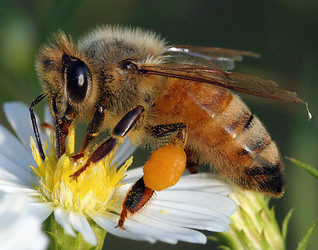
Apis mellifera. © David Cappaert Photograph courtesy InsectImages.org (#2116051)
Honeybees (Apis mellifera)
Tree of Life Link: Apinae
Apis mellifera (the European honeybee) is an introduced species in the United States. It is eusocial (meaning that it lives in colonies of closely-related individuals) and is an important pollinator of many plants in the Tucson area.
Encountering Honeybees in Tucson
Honeybees are frequently encountered during daylight hours from spring through fall, and also on warm days during winter. Look for them at flowers, where they harvest pollen and nectar. Hives are seldom encountered, but should be avoided if found, as the bees will aggressively defend their nest and can be very dangerous.
Carpenter Bees (Xylocopa californica arizonensis)
Tree of Life Link: Xylocopinae
Xylocopa are called "carpenter bees" because females build nest chambers in dead wood (especially dead agave stalks, reeds, etc.). In contrast to honeybees, these large bees are native to the Tucson area, are not eusocial, and do not produce large colonies. Females are black, while males are yellow (and rarely seen).
Encountering Carpenter Bees in Tucson
Female Xylocopa are commonly seen feeding at flowers during daylight hours from spring through fall. If you are lucky, you may be able to find a nest in dead wood.
Paper Wasps (Polistes spp.)
Tree of Life Link: Vespoidea
Paper wasps are eusocial and predaceous (they eat other insects) wasps which are common in the Tucson area. They build nests from chewed wood pulp and live in colonies with dozens of individuals.
Encountering Paper Wasps in Tucson
Like most insects, paper wasps are generally most active during the warmer parts of the year (spring through fall). They are diurnal, which means that they are active during the day. Polistes are commonly seen hunting for insect prey, but they also feed on nectar, so you may find them attending flowers like bees. If you find one of their fascinating nests, observe it but do not get too close, and do not disturb it. These wasps have a painful sting and will aggressively defend their nest if they need to.
Ants (Family Formicidae)
Tree of Life Link: Formicidae
Ants are among the most abundant, conspicuous and ecologically important insects in the Sonoran Desert. Like honeybees and paper wasps, ants are eusocial. They live in large colonies of closely-related individuals, and generally build nests underground or in rotting wood. Ants perform an amazing diversity of activities, and are important scavengers, predators, herbivores, and granivores (seed-eaters) in the Sonoran Desert. Worker ants are readily identified by their lack of wings, bent antennae, and by the presence of a petiole (a small segment which separates most of the abdomen from the rest of the body).
Encountering Ants in Tucson
Most ants in Tucson are active during the warmer parts of the year (late winter through early fall). They can be active both at night and during the day, depending on the time of year and the weather. Arizona has the highest diversity of ants in the United States, with over 300 known species. Eleven of the most commonly encountered ant species in Tucson are described below.
Leafcutter Ants (Acromyrmex versicolor)
Tree of Life Link: Acromyrmex
Leafcutter ants collect plant parts (leaves, flowers, etc.) on which they grow a specialized fungus, which they then eat. This is a classic example of a mutualism, in which two species live together and benefit from each other. The slow-moving, dark red workers have spiny bodies, and heart-shaped heads, and occur in different sizes (castes).
Encountering Leafcutter Ants in Tucson
Acromyrmex are common in Tucson. They are somewhat sensitive to very high temperatures and dry conditions, and are therefore most active during the cooler and moister parts of late winter, spring, summer, and fall. Look for trails of the workers collecting leaves from mesquite or other plants. Look also for the nest mounds, which are frequently shaped like small volcanoes and can get up to a foot tall. These ants do not bite or sting.
Aphaenogaster Harvester Ants
Tree of Life Link: Aphaenogaster
Aphaenogaster are called "harvester ants" because they gather and eat seeds. They also eat insects and any other food they can find, but are predominantly seed-eaters. The dark red workers are large and very skinny, with long legs, and they have a "beard" of long hairs on the underside of their heads (these are used to carry sand out of the nest). The workers in a colony are all the same size (unlike leafcutter ants).
Encountering Aphaenogaster in Tucson
Aphaenogaster are most common in less disturbed areas outside the city of Tucson, but they also occur within the city itself. They tolerate high temperatures and can be found foraging on very hot days. Look for single workers collecting seeds, or for their nest entrances, which are large holes in the ground surrounded by pebbles. These ants can bite, but do not sting.
Brachymyrmex patagonicus
Tree of Life Link: Brachymyrmex
Brachymyrmex patagonicus is the smallest ant you are likely to see in Tucson. It is an introduced species, originally from South America. Fortunately, it does not seem to be displacing native species. The workers are tiny and black, with relatively fat abdomens.
Encountering Brachymyrmex in Tucson
Brachymyrmex patagonicus is common in cooler and moister places within Tucson, such as shady gardens. Look for single workers foraging on the ground or on plants, or trails of workers climbing up tree trunks. Nests can sometimes be found under stones. Brachymyrmex do not bite or sting.
Carpenter Ants (Camponotus spp.)
Tree of Life Link: Camponotus
Camponotus are called "carpenter ants" because many species build nests in dry or rotting wood. However, many species (including most in Tucson) construct nests in soil. Camponotus are generalists, meaning that they eat a wide range of food items, and can be identified by their large size, relatively large eyes, smooth bodies, and multiple worker castes.
Encountering Carpenter Ants in Tucson
Camponotus are generally most active at night. Look for solitary workers on the ground and on tree trunks, where they often forage. Nests are in soil or wood. Carpenter ants do not sting, but they may bite, and they are able to spray formic acid.
Dorymyrmex spp.
Tree of Life Link: Dorymyrmex
Dorymyrmex are common ants in the Sonoran Desert. Two species are common in Tucson, D. insanus and D. bicolor. These ants are sometimes called "cone ants" because they have a distinctive cone on their bodies in front of the petiole. Workers have relatively long and thin bodies. D. insanus workers are dark brown, while D. bicolor workers have yellow or red heads and bodies but dark brown abdomens.
Encountering Dorymyrmex in Tucson
Dorymyrmex are very common ants in Tucson. They generally forage during the day, and can tolerate relatively high temperatures. Look for single workers foraging on the ground or on vegetation. Their nests are usually not very distinctive, but there are sometimes small mounds of dirt at the entrances. These ants do not sting or bite.
Forelius spp.
Tree of Life Link: Forelius
Forelius are probably the most commonly encountered ants in Tucson. They are small orange or yellow ants which seem to run frantically while foraging. They form long trails of rapidly-running workers, often going up into trees to feed at extra-floral nectaries (glands from which the tree produces sugary secretions) or from hemipteran insects.
Encountering Forelius in Tucson
Forelius are tolerant of very high temperatures, and can be found foraging on even the hottest days, when no other ants are out. Look for their distinctive foraging trails. Their nest entrances are typically just tiny holes in the ground, although they can be surrounded by small sand grains (which should help you to locate them). Forelius do not bite or sting.
Trap-Jaw Ants (Odontomachus clarus)
Tree of Life Link: Odontomachus
Odontomachus clarus is one of the most unusual ants found in the Tucson area. They are called "trap-jaw ants" because they hunt by holding their mandibles wide open and snapping them shut on prey with incredible speed and force. In fact, this has been measured to be the fastest movement by any animal! Odontomachus are easily identified by their unusual mandibles, which are long and straight, emerge from the center of the head, and are either held wide open or are held shut, sticking straight forward from the head. They are large ants, and are dark red and brown. They hunt as single workers, have small colonies, and nest in soil or rotting wood.
Encountering Trap-Jaw Ants in Tucson
Odontomachus are abundant in Tucson but are not commonly encountered. They are most active during warm and humid times, such as mornings and evenings during the summer months. Look for solitary workers hunting on the ground for termites or other prey. The workers may attempt to bite if picked up, but their formidable-looking mandibles are unable to hurt people. They do occasionally sting, so be careful when handling them.

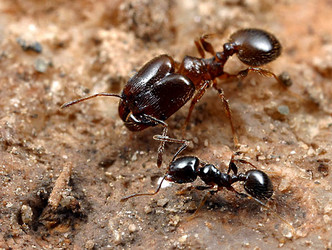
Pheidole bicarinata. © 2004 Alex Wild
Pheidole spp.
Tree of Life Link: Pheidole
Pheidole is the most diverse group of ants in the world, with more than 50 species known in Arizona. They are one of the best examples of polymorphism (multiple forms in the same species), with some workers having enormous heads and jaws, and others having small heads. The large workers (or "soldiers") use their powerful mandibles for defense and for grinding seeds, which these ants commonly feed on. They can be identified by their clubbed antennae and large-headed soldiers.
Encountering Pheidole in Tucson
Pheidole are generally not commonly seen in Tucson, although they are probably abundant. They are less conspicuous than many other ants, as they tend to be small and slow-moving. Look for them in leaf litter or under rocks. They do not sting.
Pogonomyrmex Harvester Ants ("Pogos")
Tree of Life Link: Pogonomyrmex
Pogonomyrmex are the most common large ants in Tucson. Several species occur in the area, but the most common inside the city is Pogonomyrmex maricopa. This is a large red-orange ant that carries its abdomen high in the air when running. Their nests are built in the ground and are typically surrounded by an area cleared of vegetation. Like Aphaenogaster, these ants harvest seeds for food.
Encountering Pogonomyrmex in Tucson
Pogos are abundant within Tucson and are commonly encountered. Look for their nests in the dirt along sidewalks or in cleared areas. The workers are active during the day, and are tolerant of fairly high temperatures. Be careful when observing them, however - these ants are aggressive and have very painful stings!
Pseudomyrmex spp.
Tree of Life Link: Pseudomyrmex
Pseudomyrmex are interesting ants which nest in dead branches of mesquite, oak and other trees. They have very large eyes and good vision. Two species occur in Tucson, Ps. apache and Ps. pallidus. These look virtually identical to one another, except that Ps. apache is much larger. Both are long, thin, and bright orange or orange-yellow in color. They move very quickly and are difficult to catch.
Encountering Pseudomyrmex in Tucson
Pseudomyrmex are fairly common in Tucson, but it takes some effort to find them. They are active from spring through fall, during daylight hours. Look for them on trunks and branches of mesquite trees; larger trees are more likely to have them.
Fire Ants (Solenopsis xyloni)
Tree of Life Link: Solenopsis
The South American fire ant, Solenopsis invicta, is a famous invasive ant which has been very destructive in the Southeastern United States. Fortunately, this ant has not managed to invade Arizona. We do have a native species which is similar in many respects, Solenopsis xyloni. They are easily identified by their shiny bright red heads and bodies and black abdomens, worker polymorphism (both small and large workers), and painful stings.
Encountering Fire Ants in Tucson
Solenopsis xyloni is common in relatively moist habitats in Tucson, such as lawns and gardens. Look for trails of foraging workers in leaf litter or on bare ground. They generally avoid foraging during very hot and dry periods. Be careful when observing these ants - they are aggressive and have painful stings!
Order Diptera Flies
Tree of Life Link: Diptera
Diptera are the true flies. This is a very diverse group of insects, with many common and important members. The house fly (Musca domestica) is the most familiar fly to most people, but many other flies are commonly encountered in Tucson. These include robber flies (Family Asilidae) and mosquitoes (Family Culicidae). Diptera are the best fliers of any insects, due to their specialized wing structures.
Characteristics
- One pair of wings
- Halteres (knob-like structures which help balance the fly) behind the wings
Robber Flies (Family Asilidae)
Tree of Life Link: Asilidae
Robber flies are fierce predators which feed on other insects. They are excellent fliers, have good eyesight, and can even attack large and dangerous insects, killing them with a sharp beak-like mouth. They can be recognized by their large eyes, stout bodies, long thin abdomens, and their hunting behavior: they perch on branches or twigs while keeping a lookout for prey, then swoop down low to the ground before perching on a different twig.
Encountering Robber Flies in Tucson
Asilids are common in the Tucson area, and there are many species. Look for them perched on low-lying plants, on the ground, or flying rapidly about. If you are lucky, you may get to see one catch and eat its prey!
House Flies (Musca domestica)
Tree of Life Link: Muscidae
House flies are one of the most commonly encountered and disliked insects in the world, and Tucson is no exception. These flies are generalist scavengers, feeding on a very wide range of substances. They play a very important role in breaking down trash, feces and animal corpses, but also enjoy landing on and eating fresh human food. As a result of these behaviors, they tend to spread human diseases. Their larvae, like those of many flies, are called maggots.
Encountering House Flies in Tucson
It is impossible to avoid house flies in Tucson, as they are everywhere and are attracted to human activity. While it is easy to be annoyed by them, it is also worth appreciating their ecological success and adaptability!

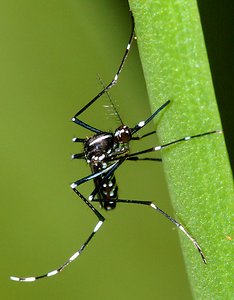
Aedes albopictus. © Susan Ellis Courtesy InsectImages.org (#1366026)
Mosquitoes (Family Culicidae)
Tree of Life Link: Culicidae
Mosquitoes are true flies, and are well-known to most people due to their blood-feeding habits. Both male and female mosquitoes feed on plant juices to obtain food, but females also need to feed on blood in order to produce eggs, which are deposited in pools of water. The larvae feed on bacteria in the water. Mosquitoes transmit many serious diseases, including malaria, dengue and yellow fever (which do not occur in Tucson), as well as West Nile Virus (which does occur in Tucson).
Encountering Mosquitoes in Tucson
Mosquitoes are surprisingly common in Tucson, considering that they need water to breed, and Tucson is in a desert. This is likely due to the heavy use of water to irrigate plants and for air conditioning, as well as an abundance of open containers which catch and hold water after rains. Mosquitoes are active in Tucson from April through late fall, and are most active around sunrise and sunset. Look for their interesting larvae in containers or pools of water, but do what you can to minimize mosquito breeding opportunities around your home!
Order Coleoptera Beetles
Tree of Life Link: Coleoptera
Coleoptera is the most diverse group of insects. In fact, there are more species of beetles than any other kind of animal in the world! They are particularly diverse in tropical rainforests, but the Sonoran Desert has many kinds of beetles as well. Some beetles are predators, while many others are herbivores (they feed on living plants), and still others feed on rotting plants or animals. Many kinds of beetles are encountered in Tucson, and four of the most commonly seen species are described below.
Characteristics
- Front wings thickened and hardened (these are called elytra)
- Hind wings folded under elytra
- Chewing mouthparts
Cactus Longhorn Beetles (Moneilema gigas)
Tree of Life Link: Cerambycidae
Cactus longhorn beetles feed on cholla and prickly pear cacti. Larvae develop and feed inside the cacti, while adults feed externally on soft cacti tissues. Moneilema are flightless, and are easily recognized by their hard black bodies, long antennae (which have a white spot at about the midpoint), paired spines on the thorax, and white stripe behind the head. Like many other cerambycid beetles, Moneilema squeak when picked up.
Encountering Cactus Longhorn Beetles in Tucson
Monoleima are often encountered in Tucson feeding on cacti or walking on the ground during daylight hours in spring and summer.
Palo Verde Borer Beetles (Derobrachus geminatus)
Tree of Life Link: Cerambycidae
Derobrachus geminatus is called the "palo verde borer beetle" because its larvae develop underground and feed on the roots of palo verde trees (and other plants). These are very large beetles, and are unmistakable. They are dark brown, with spines on the thorax, long straight antennae, and large mandibles. Females are larger than males. Like Moneilema, these beetles squeak when picked up.
Encountering Palo Verde Borer Beetles in Tucson
Derobrachus are active during summer months, and can be seen flying around sunset. They are also often attracted to lights. Be careful when handling these beetles, as their powerful mandibles can deliver a painful bite.

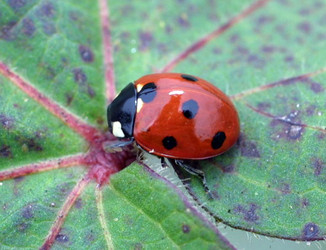
Coccinella septempunctata. © 2005 Russ Ottens, The University of Georgia Photograph courtesy InsectImages.org (#1242097)
Ladybird Beetles (Family Coccinellidae)
Tree of Life Link: Coccinellidae
Ladybird beetles ("ladybugs") are easily one of the most recognizable beetles. Their bodies are basically hemispherical (like a globe cut in half) in shape. There is actually a lot of diversity in ladybug coloration, but most common species in the United States are red or orange with varying numbers of black spots. Both adult and larval ladybugs feed on aphids and similar insects.
Encountering Ladybird Beetles in Tucson
Ladybugs are common in gardens and similar places that have a lot of aphids. They are generally active from spring through fall. In addition to the adults (which are easy to see), look for the interesting larvae, which are often found walking on the ground or on plants. The larvae are purple with orange spots, and have long mandibles.
Fig Beetles (Cotinus mutabilis)
Tree of Life Link: Scarabaeidae
Fig beetles get their name from their habit of eating fruit (they also eat sap). Adults are a dull green color (with shiny green undersides), with a tan stripe along the edges of the elytra. Larvae feed on decaying plant matter and are quite interesting to watch move, as they crawl on their backs!
Encountering Fig Beetles in Tucson
Cotinus are active from late spring through summer, and are quite common. Look for them on fruit trees, fruiting cacti, and on mesquite and other trees (whose sap they feed on). They can sometimes be seen flying in large numbers around mesquite trees. Look for the larvae in compost piles.
Order Lepidoptera Butterflies and Moths
Tree of Life Link: Lepidoptera
Lepidoptera is one of the five largest orders of insects (along with Hymenoptera, Diptera, Coleoptera, and Hemiptera). Moths and butterflies are well-known to most people. They are abundant and diverse, and are ecologically important pollinators (as adults) and herbivores (as larvae). Adults feed on nectar, which they gather from flowers (pollinating them in the process), while larvae feed on plants. Generally, butterflies are active during the day and are brightly colored, while moths are active at night and are more drabbly colored (although there are many exceptions). Butterflies tend to have clubbed antennae, while most moths have feathery antennae. Lepidopteran larvae are known as caterpillars.
Characteristics
- Wings covered in scales
- Mouthparts modified for sucking, forming a long proboscis
- Relatively large eyes

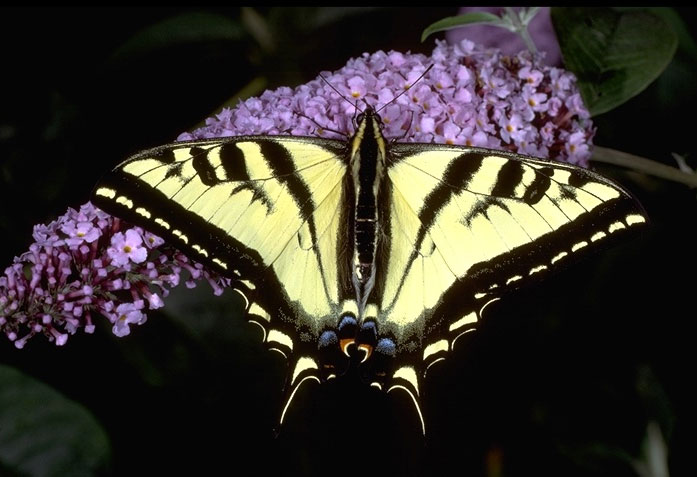
Papilio rutulus. © 1999 California Academy of Sciences Courtesy CalPhotos
Swallowtail Butterflies (Family Papilionidae)
Tree of Life Link: Papilionidae
Swallowtail butterflies are familiar to many people, as they are often very large and have striking coloration. Several species occur in the Tucson area, including the Tiger Swallowtail (yellow and black) and the Pipevine Swallowtail (black and iridescent blue, with white spots above and orange spots velow). These species have distinctive "tails" (hence the name "swallowtail") at the rear of the hind wings. Swallowtail larvae have distinctive glands called osmeteria, which look like tentacles growing from their heads. These glands emit a smelly substance that deters predators.
Encountering Swallowtail Butterflies in Tucson
Swallowtails are active from spring through fall. Look for the large winged adults flying during the day - it is hard to miss them! One species has larvae which look like bird droppings, which is very good camouflage! Look for these on the leaves of citrus trees.
Southern Dogface Butterfly (Zerene cesonia)
Tree of Life Link: Zerene
Yellow dogface butterflies are fairly large, yellow butterflies which are common in the Sonoran Desert. They are called "dogface butterflies" because the upper surface of their wings supposedly appears to have a picture of a dog's face (although it could also be interpreted as a duck). Larvae feed mainly on plants in the pea family (Leguminosae). Adults are recognizable by their spotted yellow wings and by apparently only having four legs.
Encountering Dogface Butterflies in Tucson
Zerene cesonia is active all year in Tucson, but is most abundant in the fall. Look for the adults feeding at flowers or laying eggs on leguminous plants.
White-Lined Sphinx Moth (Hyles lineata)
Tree of Life Link: Sphingidae
The white-lined sphinx moth is a very important pollinator in the Tucson region. Like other sphinx moths (Sphingidae), Hyles lineata is a very fast and powerful flyer. They are able to hover while feeding, quickly moving between flowers. Unlike most moths, Hyles lineata is often active during the day, although they are also active at night. Both the thick, chunky bodies and triangular wings of the adults are striped (hence the name "white-lined sphinx moth"). The hind wings have a patch of pink, but otherwise these moths are brown and white. The caterpillars are abundant at times and are bright yellow (or occasionally black).
Encountering White-Lined Sphinx Moths in Tucson
Hyles lineata is active during the summer and can be quite abundant. Look for the adults feeding at flowers, especially in the evening. Larvae feed on a range of different host plants, and are very noticeable when present.
Order Neuroptera Lacewings and Antlions
Tree of Life Link: Neuroptera
Neuroptera is an interesting group of insects that is unfamiliar to many people. The most commonly encountered members of this order are the lacewings and antlions. Both adult and larval neuropterans are predaceous.
Characteristics
- Four large membranous wings with many veins
- Soft bodies
- Long antennae
Green Lacewings (Family Chrysopidae)
Tree of Life Link: Chrysopidae
Green lacewings are the most commonly seen neuropterans in Tucson. Adults are a bright green color with large, delicate clear wings. Both adults and larvae feed on aphids and other soft-bodied insects. Brown lacewings, which belong to a different family, are also sometimes seen in Tucson.
Encountering Green Lacewings in Tucson
Green lacewings are active from spring through fall. They are often seen flying away from disturbed plants during the day. They are generally nocturnal and are usually seen flying after sunset. They are often attracted to lights at night. The larvae are not commonly encountered. Look for lacewing eggs on plants - they are laid singly on plant leaves, and look like tiny white pearls on long stalks.
Antlions (Family Myrmeleontidae)
Tree of Life Link: Myrmeleontidae
Antlions are neuropteran insects with very interesting feeding behaviors. The larvae dig pits in loose sand and wait at the bottom. Small ground-dwelling insects (especially ants) which fall into the pits are unable to escape and are eaten by the larvae. If the prey does manage to climb the walls of the pit, the antlion will flick sand at it, knocking it back to the bottom of the pit. Adults are also predaceous, but are not as commonly encountered as the larvae. They are large, gray insects with clubbed antennae and large wings.
Encountering Antlions in Tucson
Antlions are common in Tucson. Look for the larval pits in patches of loose, sandy soil. If you scoop up the sand at the bottom of the pits, you will find the larva, which has large mandibles and looks fearsome, but is harmless to people. Look for adults near lights at night in the summer months.
Order Hemiptera True Bugs, Aphids and Cicadas
Tree of Life Link: Hemiptera
Hemiptera is the largest order of hemimetabolous insects (those insects which do not undergo a complete metamorphosis). It is one of the most important groups of herbivorous insects. Nearly all hemipterans are herbivorous and suck plant juices, although a small number are predaceous or parasitic. Hemiptera includes many familiar insects, including aphids (Aphididae), cochineal scale insects, cicadas, and milkweed bugs. Members of one subgroup of Hemiptera, the Heteroptera, are called the "true bugs".
Characteristics
- Sucking mouthparts

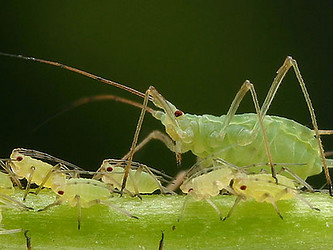
Acyrthosiphon pisum. © 2003 Alex Wild
Aphids (Family Aphididae)
Tree of Life Link: Aphididae
Aphids are one of the most familiar hemipterans to many people. They are very common and have unusual life cycles. They can reproduce both sexually and asexually, and produce both winged and wingless forms, depending on the current conditions and the phase in the life cycle. Aphids are very soft-bodied and come in a range of colors (green, red, yellow, even black).
Encountering Aphids in Tucson
Aphids are commonly found on a wide variety of plants. Look for large clusters of them on new plant growth (such as young leaf or flower buds). You will often see a mixture of both winged and wingless aphids, of various sizes. Look for aphid "mummies", which are swollen brown carcasses of aphids that have been parasitized by wasps. You may also find aphids being eaten by adult or larval ladybugs or lacewings.
Cochineal Scale Insects (Dactylopius confusus)
Tree of Life Link: Dactylopiidae
Cochineal scales are tiny insects that suck juices from prickly pear cacti (Opuntia spp.). They secrete a white waxy coating around their bodies to protect themselves from desiccation and predation. Dactylopius also produce a beautiful red substance (also called cochineal, or carmine) which has historically been an economically important dye in some parts of Latin America, and is still used to a lesser extent today.
Encountering Cochineal Scale Insects in Tucson
Cochineal scales are very common in Tucson and can readily be found on many species of prickly pear cacti. Look for the cottony white coatings on cactus pads. They can occur singly or in large clusters. If you scrape away the waxy covering you will find the small insect, which is attached to the cactus. Try crushing one in order to see the bright red dye!
Desert Cicada (Diceroprocta apache)
Tree of Life Link: Cicadidae
Cicadas are best known for their ear-piercing songs, which males use to attract females for mating. These insects feed on the watery liquids (not sap) inside trees, which they access by piercing branches with their sucking mouthparts. Cicada nymphs feed from tree roots underground and take several years to develop. Adults are thick-bodied and are excellent fliers. Desert cicadas are the only insects in the world known to "sweat", which helps them stay cool and allows them to be active even during the hottest times of summer days.
Encountering Desert Cicadas in Tucson
Diceroprocta apache is active during daylight hours in late spring and summer, and is easily found by following their loud songs to the source, usually on branches of mesquite and other trees. They also sometimes come to lights at night. Look for their exoskeletons on tree trunks in late May.
Milkweed Bug (Lygaeus kalmii)
Tree of Life Link: Lygaeidae
Lygaeus kalmii are perhaps the most commonly encountered "true bugs" in Tucson. These red, gray, black, and white insects feed on seeds and nectar of milkweed (and other plants), and store toxins from the milkweed plants in order to deter predators. Nymphs are bright red with black wing buds.
Encountering Milkweed Bugs in Tucson
Milkweed bugs are very common in Tucson throughout most of the year. Look for them walking on the ground in search of seeds, or on plants. Nymphs tend to cluster together on plants and are hard to miss!
Order Orthoptera Crickets and Grasshoppers
Tree of Life Link: Orthoptera
Orthoptera is a large group which consists of the familiar grasshoppers, crickets and katydids. Orthopterans do not undergo complete metamorphosis, so immature individuals simply look like small adults (with undeveloped wings). Most orthopterans are herbivorous, and many species make sounds using their wings (and hear them using "ears" on their abdomens or legs).
Characteristics
- Chewing mouthparts
- Elongate thickened front wings called "tegmina" (though some orthopterans are wingless)
- Elongate body
- Well-developed cerci (sensory organs at the tip of the abdomen)
Gray Bird Locust (Schistocerca nitens)
Tree of Life Link: Acrididae
Schistocerca are probably the most commonly encountered orthopterans in Tucson. They are large grasshoppers and are strong fliers. Adults are a grayish-tan color, while nymphs (juveniles) are bright green. They feed on a wide variety of native and introduced plants. Adults can make a "clacking" sound with their wings as they fly.
Encountering Gray Bird Locusts in Tucson
Schistocerca nitens is active from spring through fall. Look for them feeding on plants or resting during daylight hours. They are also often attracted to bright lights at night (e.g. lights at large parking lots). They are very common and are frequently encountered.
Order Dermaptera Earwigs
Tree of Life Link: Dermaptera
Dermaptera is a small group of insects which are commonly known as "earwigs". This name stems from the belief that they crawl into people's ears. Together with the fearsome-looking "pincers" at the end of their abdomens, this causes many people to fear dermapterans, though fortunately they are harmless to humans. The pincers are used in prey capture and defense. Most earwigs are omnivorous, eating both plants and insect prey. They live in humid places, such as under rocks. They are unusual among insects in that females take care of their young offspring.
Characteristics
- Leathery front wings
- Soft bodies
- Abdomen with a pair of enlarged hardened cerci (pincers)
- Chewing mouthparts
European Earwig (Forficula auricularia)
Tree of Life Link: Dermaptera
Forficula auricularia is an introduced species from Europe which is now present throughout much of the United States and Canada, including Arizona. These insects are omnivorous, feeding on both plants and other insects. Adults are dark brown with yellowish legs.
Encountering European Earwigs in Tucson
F. auricularia is nocturnal, but during the day you can look for them in moist places such as under rocks or potted plants. They can be found throughout the year.
Order Blattaria Cockroaches
Tree of Life Link: Blattaria
Cockroaches are familiar to everyone but are largely misunderstood. Though some species do inhabit urban settings and can be pests, most cockroaches are harmless to people, perform important ecological functions and are actually quite beautiful. Cockroaches are generally omnivorous and nocturnal. Roughly twenty species are known to occur in Arizona, about half of which are introduced (non-native) species.
Characteristics
- Flattened oval body
- Head concealed from above by thorax
- Leathery front wings
- Long one- or multi-segmented cerci (sensory organs at tip of abdomen)
American Cockroach (Periplaneta americana)
Tree of Life Link: Blattidae
Periplaneta americana is one of the most commonly encountered cockroach species in Tucson, and is also one of the largest (up to 2 inches long). It does not enter houses as readily as some other species, such as the German cockroach, Blatella germanica or the Brown-banded cockroach, Supella longipalpa, but it does do so. Adults are mostly reddish-brown, though the pronotum (first segment of the thorax) is yellow and contains two large brown spots.
Encountering American Cockroaches in Tucson
Look for P. americana foraging outside at night, or in moist dark places during the day. They can also be found inside buildings in dark moist locations.
Order Isoptera Termites
Tree of Life Link: Isoptera
Isoptera consists of the termites, which are actually close relatives of cockroaches and mantids but are eusocial like ants. Unlike ants, termite colonies have both queens and kings (ant colonies only have queens), who do most of the reproduction within the colony. Termite life-cycles can be complex, with multiple worker castes (including soldiers) and secondary reproductive castes.
Termites eat dead plant matter, often including wood. They are able to digest cellulose through the assistance of diverse communities of symbiotic microorganisms which inhabit their guts. Most termites are subterranean, forming diffuse nests in the soil. They are both ecologically and economically important. Arizona has nearly 20 species of termites.
Characteristics
- Wingless (reproductive castes have wings prior to colony foundation)
- Soft pale bodies
- Chewing mouthparts
- Abdomen broadly joined to thorax
- Eusocial
Arid-Land Subterranean Termite (Reticulitermes tibialis)
Tree of Life Link: Reticulitermes
Reticulitermes tibialis is the most common termite in Arizona and does a good deal of damage to human-built structures. The species is native to Arizona (and much of the western U.S.) and normally feeds on creosote and other plants. These termites can be difficult to distinguish from other species.
Encountering Reticulitermes tibialis in Tucson
Look for subterranean termites in dry or moist soil. They can sometimes be found by lifting rocks. Look for the tubes they construct in order to travel between the soil and a food source. Breaking these tubes often reveals the termites underneath. Look also for the winged alates (reproductives), which emerge after soaking rains and fly off to mate and found new colonies.
Order Mantodea Mantises
Tree of Life Link: Mantodea
Mantodea contains the mantises, which are familiar to most people due to their unusual appearance and behaviors. Mantises are predators and generally hunt their insect prey using ambush tactics: they will sit still on vegetation and wait for potential prey to pass by, and will then rapidly reach out and grab the prey with their highly specialized front legs (which they normally hold in a raised "praying" posture). Ten species occur in Arizona.
Characteristics
- Front legs highly modified for grabbing prey
- Elongate bodies
- Highly mobile head
- Eggs deposited in egg cases on vegetation
Encountering Mantises in Tucson
Mantises are active during the warm months of the year. Look for them during the day on vegetation or on the ground. Mantis species in Arizona vary significantly in their appearance - some are large and green, while others are small and tan or grey. They are often well camouflaged, so look carefully! Mantises also sometimes fly to lights at night, so look for them there. Look also for the egg cases, which are hard and tan and are generally placed on twigs or other vegetation.
Order Embiidina Webspinners
Tree of Life Link: Embiidina
Webspinners are interesting insects which are predominantly tropical in distribution, though two species occur in Arizona. Embiids spin silken coccoons under rocks or in similar tight spaces using silk glands on the front legs. Adult females are wingless and inhabit these coccoons, rearing their brood within the protected space; they are among the only non-social insects to exhibit brood care. Adult males are generally winged, though they can be wingless in some species. Embiids feed on dead plant matter.
Characteristics
- Front legs swollen by silk glands
- Winged (males) or wingless (males or females)
- Wings with blood sinuses (allowing wings to be either flexible or stiff)
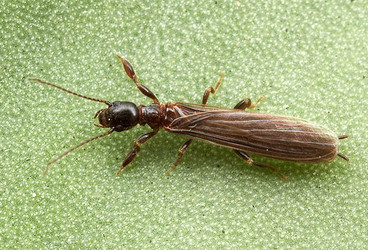
Oligotoma nigra. © 2007 Alex Wild
Oligotoma nigra
Tree of Life Link: Oligotoma
Oligotoma nigra is an Old World species which has become established in the southwestern U.S. and is the most commonly encountered webspinner species in Arizona. Males are winged and have dark brown bodies.
Encountering Oligotoma nigra in Tucson
Females of Oligotoma nigra are rarely encountered in Tucson, but look for their silken coccoons under rocks or similar microhabitats. The winged males are much more commonly encountered. They are attracted to lights and often fly into houses during the warm months of the year.
Information on the Internet
- BugGuide.Net An online community of naturalists who enjoy learning about and sharing observations of insects, spiders, and other related creatures.
- Common Arthropods of Tucson, Arizona Pima Community College
- The Firefly Forest A combination nature journal and species identification guide with photographs, stories, and information primarily about Tucson, Arizona and Sonoran Desert wildflowers, plants, birds, animals, and other wildlife, as well as many other related (and unrelated) things.

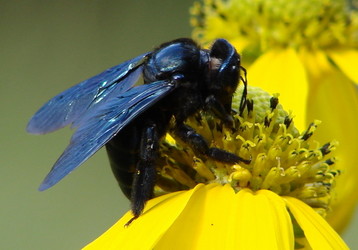
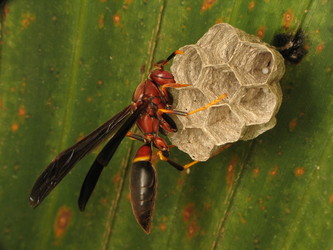
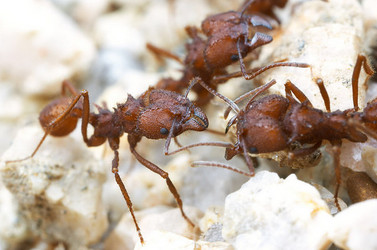
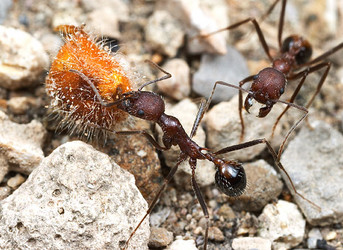
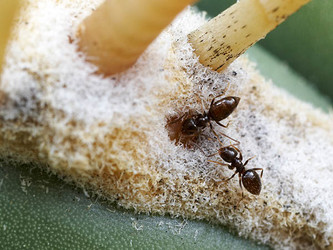
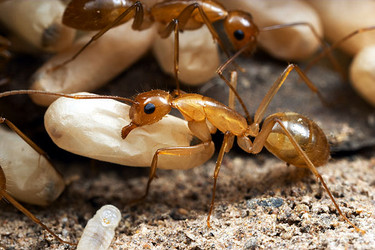
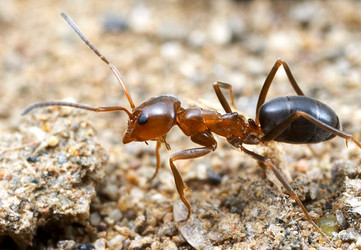

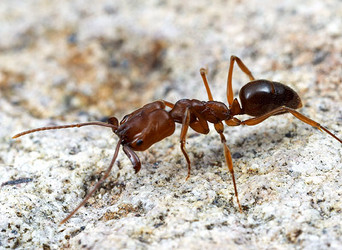
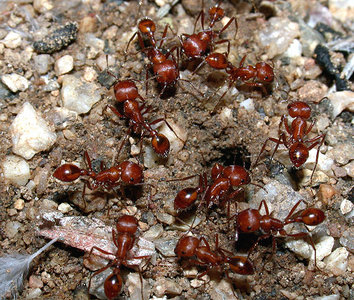
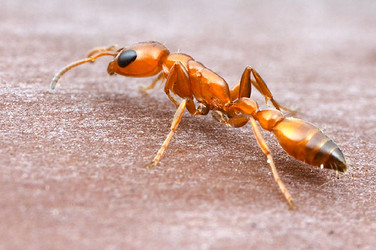
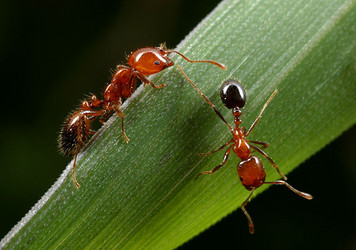


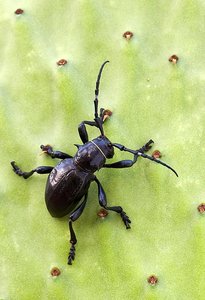
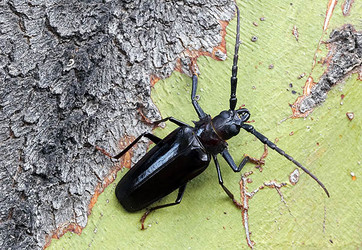
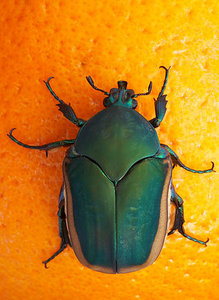

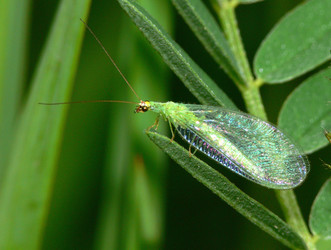
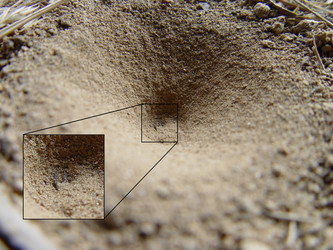
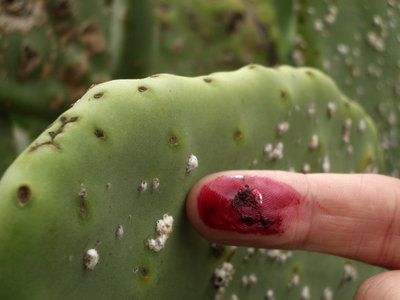

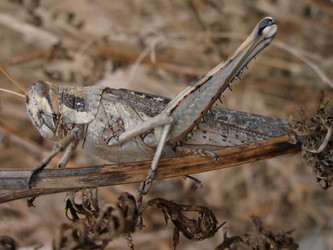
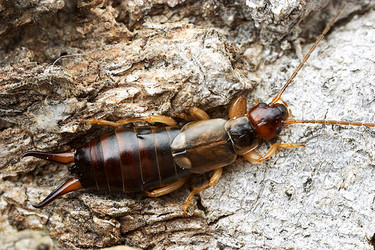
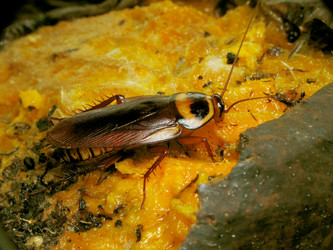
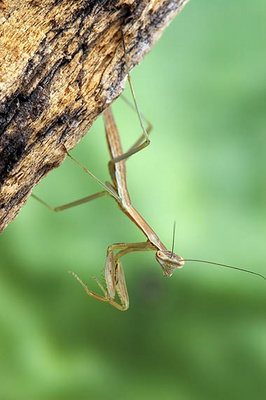
 This page was developed
as part of the project "New Strategies for Life Sciences Outreach in
Arizona: Developing a Digital Library of Audio and Video Features in the
Context of the Tree of Life Web Project" funded by the “Anyplace
Access for Arizonans” Initiative under the
This page was developed
as part of the project "New Strategies for Life Sciences Outreach in
Arizona: Developing a Digital Library of Audio and Video Features in the
Context of the Tree of Life Web Project" funded by the “Anyplace
Access for Arizonans” Initiative under the 



 Go to quick links
Go to quick search
Go to navigation for this section of the ToL site
Go to detailed links for the ToL site
Go to quick links
Go to quick search
Go to navigation for this section of the ToL site
Go to detailed links for the ToL site